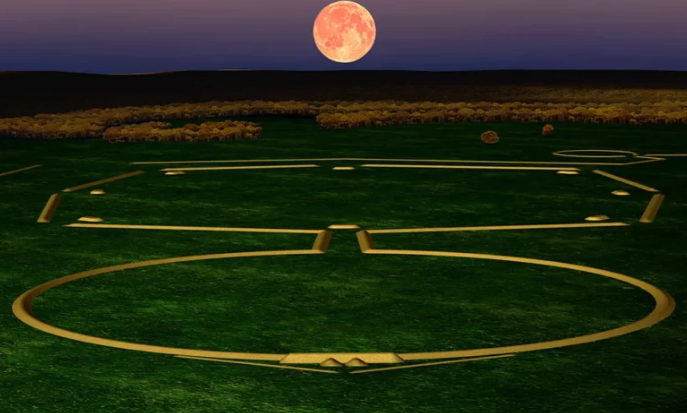**Rediscovering America’s Ancient Earthworks: A Journey to the Hopewell Ceremonial Structures**
Constructed by an enigmatic civilization that left no written trace, these monumental earthworks are now open to the public for the first time in over a century. As autumn leaves crunched underfoot, I joined a group of enthusiastic tourists, following our guide along a verdant hillside. We paused at the entrance to a grassy circle outlined by a wall of earthen mounds, known as the Octagon. This remarkable site is part of the Hopewell Ceremonial Earth Structures, an extensive network of hand-built mounds in central and southern Ohio, created approximately 2,000 years ago. Indigenous peoples journeyed hundreds of miles to the Octagon for communal rituals and ceremonies.
“There used to be a steam bath or a place for spiritual cleansing here,” our guide, Brad Lepper, a senior archaeologist with the World Heritage Program at the Ohio History Connection, explained while gesturing around. When I glanced inside, I was surprised to see a well-maintained golf course, with a tall flag marking one of the holes.
This unusual juxtaposition occurred because from 1910 until 2024, the Octagon served as a golf course. However, starting January 1, 2025, this ancient and intriguing site will welcome visitors again after more than a century.
These prehistoric ceremonial structures were constructed by what is now referred to as the Hopewell Culture—a network of Native American societies that convened from as far as Montana to the Gulf of Mexico between about 100 B.C. and 500 A.D., linked through a system of trade routes. The earthen structures in Ohio feature various geometric shapes, including circles, squares, and octagons, often interconnected. Archaeologists are only now beginning to grasp the complexity of these engineering feats.
Built with remarkable mathematical precision and intricate astronomical alignments, these structures are the largest geometric earthen works in the world not created for fortification. Despite their relative obscurity, awareness of these sites and their creators may be on the rise.
In 2023, UNESCO recognized eight of the Hopewell earthen structures as World Heritage Sites, including the Great Circle and the Octagon in Newark, Ohio, along with Fort Ancient—Ohio’s first state park (despite not being a fort). The remaining five sites are part of the Hopewell Culture National Historical Park: Mound City, Hopeton Earth Structures, High Bank Structures, Hopewell Mound Group, and Seip Earth Structures.
Lepper informed me that the Octagon and the Great Circle were part of a larger Hopewell complex that spanned 4.4 square miles, connected by earthen walled pathways. Today, walking through these sites evokes a sense of awe due to their vast sizes. The Great Circle, which houses the Hopewell Ceremonial Earth Structures Museum, has a diameter of 1,250 feet (366 meters) and walls reaching up to 14 feet (4.3 meters) tall, surrounded by a deep moat. Once linked to a square structure and a burial ellipse, only fragments of the square are visible today. Meanwhile, the Octagon covers a sprawling 20 acres and is adjacent to the Observation Circle, a large terrestrial structure used for gatherings and sky observation rituals. “You could fit four of Rome’s Colossi within the Octagon alone,” Lepper noted, adding that “Stonehenge would fit inside that small circle now utilized as a golf course.” He emphasized that these remarkable structures were built by indigenous workers using only rudimentary tools, digging earth with sharp sticks and transporting it in wicker baskets. Estimates suggest they moved around 200,000 cubic yards of earth.
The achievement of the Hopewell Culture lies not only in their ability to create large and precise shapes without any elevated perspective but also in their incorporation of a hidden geometry within these constructions. Initially, it was believed that these builders lacked advanced mathematical or geometric knowledge due to the absence of written records. However, subsequent measurements revealed that they had employed precise calculations that linked the earthen structures in unexpected relationships.
Lepper pointed out that the perimeter of the Great Circle “is equal to the perimeter of the perfect square it connects to,” and “the area of that perfect square equals the area of the Observation Circle linked to the Octagon.”
He elaborated: “If you draw a square inside the Octagon by connecting the diagonal corners, the sides of that square [321 meters] equal the diameter of the circle it connects to [321 meters].”
Archaeological findings have continually uncovered relationships between the structures. According to Lepper, this measurement of 321 meters—whether halved or doubled—is also present in other indigenous structures throughout the country, serving as a common unit of measurement.
While the Hopewell Culture’s geometric and mathematical prowess astonished researchers, further analysis unveils another layer of sophistication: astronomical alignment.
In the 1980s, two professors from Earlham College in Indiana, physicist and astronomer Ray Hively, and philosopher Robert Horn, chose to examine the Octagon and its associated Observation Circle. Intrigued by the connections observed in places like Stonehenge, they sought to determine if these earthworks were also linked to a solar calendar.
Hively and Horn did not find a solar correlation but considered the lunar cycle instead.
Initially doubtful that intentional lunar connections were possible at Newark—given that a full moon cycle spans 18.6 years—they discovered that this cycle aligned perfectly with the vantage point from Observation Hill in the Observation Circle. From this point, one can witness the Moon rise directly at the center of the Octagon every 18.6 years.
“Astronomical alignments hold significance only when tied to belief systems that impart meaning to life,” articulated Timothy Darvill, an archaeology professor at Bournemouth University who has researched both Stonehenge and the Hopewell structures. “The sky-watching ceremonies likely had the dual purpose of reinforcing community bonds.”
This ancient culture’s significance contributed to its inclusion on the UNESCO World Heritage List.
A UNESCO archaeological site must demonstrate “outstanding universal value,” stated Jennifer Aultman, director of historic sites and museums at the Ohio History Connection, which spearheaded the UNESCO inclusion process. One criterion is that these sites represent “masterpieces of human creative genius,” showcasing notable mathematical, geometric, and astronomical features. Another criterion acknowledges them as “extraordinary testimony to the cultural tradition that produced them.” Aultman explained, “By examining and learning about these works, we gain insight into the lives of these people and what mattered to them.”
For instance, the moon’s apparent significance to the Hopewell culture cannot be overlooked. Darvill noted that many cultures revered celestial bodies like the sun and moon, attributing them with influence over daily life. Thus, it’s conceivable that the moon represented a common deity for those who gathered at these earthworks.
Megan Wood, executive director of the Ohio History Connection, remarked, “The lands now known as Ohio boast some extraordinary structures constructed by Native Americans thousands of years ago.” While not all of these earthworks were built by the Hopewell (such as the Serpent Mound in Peebles, Ohio, linked to solar significance), she views them all as iconic symbols of “Native cultural achievement.”
Given that the Hopewell culture left no written records, the earthworks and a few excavated artifacts serve as the remaining vestiges of their civilization. Ongoing excavations at some sites have yielded artifacts such as ritual pipes and a stunning stone statue, known as the “Newark Shaman,” depicting a shaman clothed in bearskin and holding a human skull. Artifacts representing the diverse origins of the people have also been recovered, including animal-shaped pipes, a copper head plate, and a volcanic glass knife.
As the Hopewell culture began to decline around 500 A.D., other indigenous tribes became the stewards of the land. Among them was the Shawnee tribe, who inhabited Ohio before their forced removal across the Mississippi River in the 1830s.
“We may not have built these structures, but my ancestors lived here, preserved them, and paid them the respect they deserve,” said Chief Glenna Wallace of the Eastern Shawnee Tribe of Oklahoma. She advocates for greater involvement of Native American tribes in safeguarding the Hopewell Earthworks and communicating their cultural significance.
For many years, the Octagon was managed by the Moundbuilders Country Club. After prolonged negotiations, an agreement was reached in 2024 to transfer the long-term lease of the location to the historical society, allowing the site to open to the public starting January.
For proponents of preserving the site, the UNESCO recognition and the reopening of these ancient mounds to visitors mark a pivotal moment for educating the public about Native American history in Ohio. It also heralds increased participation by Native Americans, such as the Shawnee, in sharing their perspectives on this legacy for future generations.
“I want people to learn about it,” Chief Wallace expressed. “I want them to visit and understand that this represents a priceless cultural phenomenon.”




